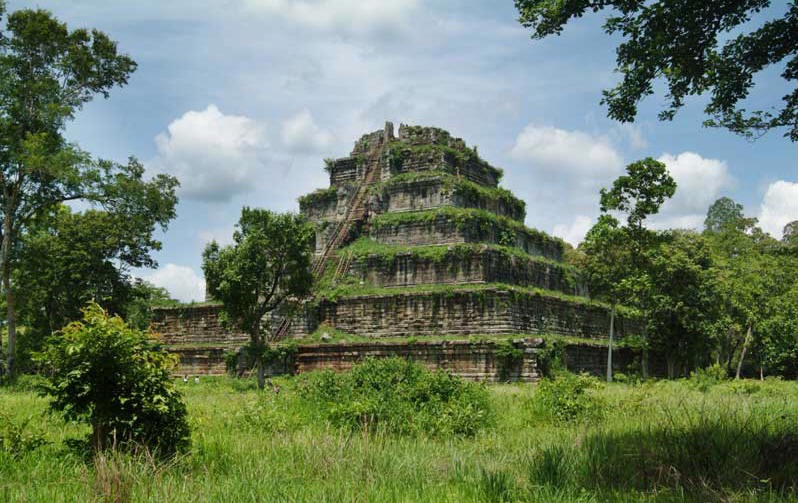The Koh Ker Pyramid, also known as Prasat Thom, is a remarkable ancient structure located in northern Cambodia. It stands as a testament to the architectural prowess of the Khmer Empire. Built in the 10th century under the reign of King Jayavarman IV, this pyramid was part of the once-majestic city of Koh Ker, which briefly served as the capital of the empire. The site is notable for its towering temple-mountain, which was a significant departure from the flat temple complexes that characterized earlier Khmer architecture. The pyramid remains an enigmatic piece of history, attracting scholars and tourists alike with its unique design and mysterious past.
Get your dose of History via Email
Historical Background of Koh Ker Pyramid
French archaeologists rediscovered Koh Ker in the 19th century. The site had been consumed by the jungle for centuries. King Jayavarman IV built the pyramid in the 10th century. He moved the capital from Angkor to Koh Ker, where it remained for a brief period. The pyramid served as the state temple of the new capital. It is a unique structure in Khmer architecture due to its towering height and stepped design.
After Jayavarman IV’s death, the capital moved back to Angkor. However, Koh Ker remained an important religious site. Over the years, it fell into disrepair and was overtaken by the surrounding jungle. The site’s remote location kept it hidden for many years. It was not until the 20th century that efforts began to study and restore Koh Ker.
Local legends and inscriptions suggest that Koh Ker was once a thriving city. It housed tens of thousands of people. The pyramid itself was likely the center of a large complex. This complex included palaces, residential areas, and other temples. The site’s abandonment remains a topic of speculation among historians.
Throughout history, Koh Ker has seen various uses. It has been a place of worship, a royal capital, and even a strategic location during conflicts. The pyramid has withstood the test of time. It remains a powerful symbol of the Khmer Empire’s ambition and ingenuity.
The Koh Ker Pyramid has not been the scene of any known historically significant events since its construction. However, its rediscovery and subsequent study have provided valuable insights into the history and culture of the Khmer Empire. The site continues to be an important focus for archaeological research and conservation efforts.
About Koh Ker Pyramid
The Koh Ker Pyramid is a seven-tiered structure rising 36 meters high. It is the tallest temple built during the Khmer Empire. The pyramid’s design is reminiscent of ancient Mayan architecture. However, it is a unique example of Khmer engineering. The structure is built from sandstone blocks. These blocks were quarried from nearby mountains and transported to the site.
The pyramid’s base measures 62 meters across. Each tier of the pyramid is smaller than the one below it. This creates a towering, mountain-like profile. The top platform was likely home to a significant religious statue or shrine. However, this has not survived to the present day. The pyramid’s design suggests it was meant to represent Mount Meru, the home of the gods in Hindu mythology.
Architectural highlights of the Koh Ker Pyramid include its false doors and intricate carvings. These adorn the sandstone blocks. The site also features a series of galleries and sanctuaries. These surround the main pyramid. They are indicative of the complex religious and social activities that took place here.
The methods of construction for the Koh Ker Pyramid remain a topic of study. The precise techniques used to quarry, transport, and assemble the massive sandstone blocks are not fully understood. However, the ingenuity and resourcefulness of the Khmer builders are evident in the structure’s enduring presence.
Despite its grandeur, the Koh Ker Pyramid is just one part of a much larger archaeological site. The surrounding area contains over 40 major structures and countless minor ruins. These spread across an 81 square kilometer area. The entire site offers a fascinating glimpse into the urban planning and architectural achievements of the Khmer Empire.
Theories and Interpretations
Several theories exist about the purpose and significance of the Koh Ker Pyramid. The most widely accepted theory is that it served as a state temple. It was a representation of Mount Meru for the Khmer Empire’s capital at Koh Ker. The pyramid’s design and orientation align with Hindu cosmology. This suggests a strong religious function.
Mysteries surround the pyramid, including the reasons for its construction and the rapid abandonment of Koh Ker as the capital. Some scholars speculate that political upheaval or resource depletion may have prompted the return of the capital to Angkor. Others suggest that the site’s water management system was unsustainable, leading to its decline.
The interpretation of the pyramid’s iconography and inscriptions has provided insights into the religious and cultural practices of the time. The carvings depict Hindu deities and mythological scenes. These suggest that the site played a significant role in the spiritual life of the Khmer people.
Dating of the Koh Ker Pyramid has been carried out using architectural styles and inscriptions. These date back to the reign of Jayavarman IV. However, the exact timeline of the site’s construction and use is still being refined through ongoing research.
Archaeological methods, including excavations and surveys, have been employed to understand the site better. These methods have revealed the complexity of the urban layout and the advanced engineering skills of the Khmer builders. The site continues to be a focus for archaeological study and conservation efforts.
At a glance
Country: Cambodia
Civilization: Khmer Empire
Age: 10th century AD
Conclusion and Sources
Reputable sources used in creating this article include:
- Wikipedia: https://en.wikipedia.org/wiki/Koh_Ker

